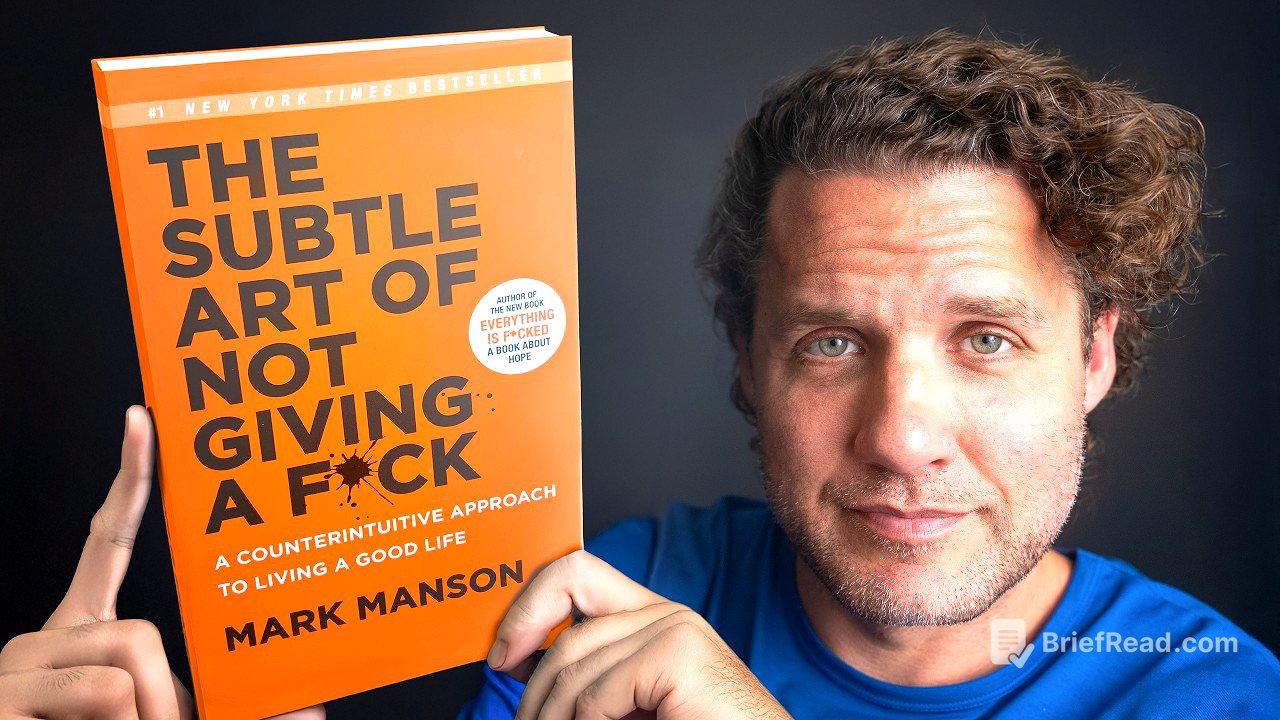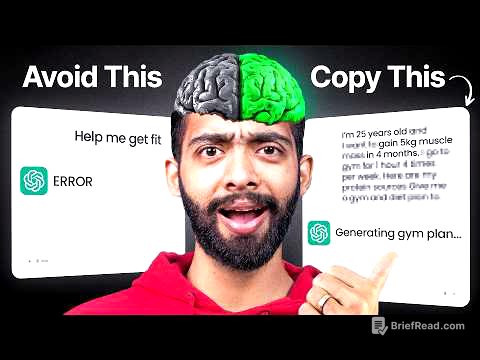Brief Summary
Mark Manson summarizes his book, "The Subtle Art of Not Giving a [ __ ]," chapter by chapter, explaining the core concepts and challenging conventional self-help advice. The book emphasizes the importance of choosing what to care about, accepting negative experiences, and understanding that suffering and failure are integral to a meaningful life. Manson encourages readers to question their values, take responsibility for their choices, and confront their mortality to live more authentically.
- The book is about values and choosing what to care about.
- Negativity is the path to positivity.
- Suffering and failure are important for growth.
- Responsibility and uncertainty are key to a fulfilling life.
- Confronting death helps clarify what truly matters.
Introduction: The Goal of the Book
The book is not about indifference but about choosing what to care about. It challenges cultural definitions of success, arguing that many commonly held values may not be the right fit for everyone. The goal is to encourage readers to critically examine their assumptions and determine what goals they should pursue, rather than blindly chasing societal expectations. The author intentionally contradicts typical self-help advice to grab attention and prompt deeper reflection.
Chapter 1: Don't Try
The chapter starts with the story of Charles Bukowski, a successful writer who lived a chaotic and unconventional life, to counter the typical success stories. The main idea is the "backwards law," which states that the pursuit of positive experience is a negative experience, while accepting negative experience is a positive one. The more you pursue feeling better, the less satisfied you become, as the pursuit reinforces the lack of it. The chapter introduces the "give a [ __ ]" framework, emphasizing that it's impossible to not care about something, so the key is to choose what to care about. It also highlights the importance of caring about something more important than adversity and recognizing that you are always choosing what to care about.
Chapter 2: Happiness is a Problem
This chapter opens with the Buddhist concept of dukkha, the idea that life is inherently filled with suffering due to attachment. Suffering has evolutionary usefulness, as dissatisfaction and anxiety drive survival and replication. Negative emotions serve as important signals, and ignoring them can be limiting. The chapter also discusses the hedonic treadmill, where happiness is always just out of reach, no matter what you achieve. Happiness comes from solving problems, and the key is to choose struggles that you enjoy having. The chapter concludes by emphasizing that everyone wants a happy life, but the more important question is what pain are you willing to struggle for, as that determines how your life turns out.
Chapter 3: You Are Not Special
The chapter begins with a story about a con man named Jimmy to illustrate the concept of entitlement, defined as feeling deserving of happiness without sacrifice. There are two forms of entitlement: grandiose narcissism (thinking you're better than everyone) and victim narcissism (thinking you're worse than everyone), both leading to self-absorbed behavior. The growing culture of exceptionalism, fueled by social media and consumer culture, drives entitlement and delusional beliefs. The chapter closes by stating that emotional health comes from accepting the mundane truths of life, such as the fact that your actions may not matter much in the grand scheme of things and that much of life will be boring, which is okay.
Chapter 4: The Value of Suffering
This chapter shifts the focus to values and what is worth sacrificing for. It opens with the story of Hiroo Onoda, a Japanese soldier who continued fighting World War II for 27 years after it ended, to illustrate that having the wrong goal can negate discipline and motivation. The chapter discusses good and bad values, defining good values as reality-based, socially constructive, and immediate/controllable, while bad values are superstitious, socially destructive, and not immediate/controllable. The rest of the book will propose five counterintuitive classes of values to care about.
Chapter 5: You Are Always Choosing
This chapter argues that you are always choosing your struggles, whether you realize it or not. It presents a thought experiment about running a marathon to highlight that the perception of choice makes struggles more acceptable. The chapter emphasizes that responsibility and fault are different; you may not be at fault for a situation, but you are always responsible for how you deal with it. Even in difficult situations, you are choosing how to value each experience. Becoming aware of your choices makes you more comfortable with pain and motivates you to take action. The chapter addresses objections to this idea, such as genetics, life situations, trauma, and cultural pressures, asserting that there are no excuses for not taking responsibility.
Chapter 6: You Are Wrong About Everything (But So Am I)
The chapter starts with a thought experiment about how beliefs change over time, suggesting that everything we think is true today will seem ridiculous in the future. It discusses the dangers of certainty, using the example of a cyber stalker with unshakable but crazy beliefs. Uncertainty opens up space for learning, guards against extremism, and improves relationships. Manson's law of avoidance states that the more something threatens your identity, the more you will avoid it. The chapter suggests defining yourself loosely to avoid clinging to faulty ideas. It concludes with questions to help you become more uncertain: What if I'm wrong? What would it mean if I were wrong? Would being wrong create a better or worse problem?
Chapter 7: Failure Is The Way Forward
This chapter argues that failure is a crucial component of success. It includes stories about Picasso's failures and the theories of psychologist Kazimierz Dabrowski, who studied Holocaust survivors. The main concept is the "do something principle," inspired by the author's high school math teacher, Mr. Packwood. The principle suggests that if you're stuck, just rewrite the problem, as action leads to motivation. The chapter emphasizes that taking even the smallest action can lead to progress.
Chapter 8: The Importance of Saying No
This chapter focuses on relationships and the importance of setting boundaries. A healthy relationship involves two people who are comfortable saying and hearing no from each other. Rejecting certain things is necessary to prioritize what you value. People who struggle to say no often feel lost and unsure of what they want. Saying no is the basis of boundaries in relationships, and being willing to disappoint your partner builds trust. The chapter concludes by discussing the hidden freedom of commitment, where limiting yourself to a few important things allows you to focus your energy and mental freedom.
Chapter 9: And Then You Die
This chapter discusses how death crystallizes what matters in life. It opens with a story about a friend who died at a party when the author was 19, which was a transformative experience. Confronting death clarifies what you should care about. The chapter suggests regularly questioning your own mortality and considering what you would do if you had limited time left. It references philosopher Ernest Becker and shares a personal anecdote about the author's attraction to heights, which forces him to confront fear and consider his life. The chapter ties together the book's major concepts, such as tolerating negative experiences, taking responsibility, being uncertain, tolerating failure, and being willing to say no, all within the context of death and its ability to elucidate what is meaningful.









